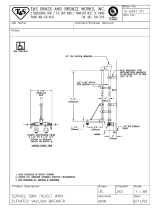1. The following should always be observed for safety
• Please report to or take consent by the supply authority before connection to the system.
• Be sure to read "THE FOLLOWING SHOULD ALWAYS BE OBSERVED FOR SAFETY" before installing
the air conditioner.
• Be sure to observe the cautions specified here as they include important items related to safety.
• The indications and meanings are as follows.
• After reading this manual, be sure to keep it together with the instruction manual in a handy place on the
customer's site.
Could lead to death, serious injury, etc.
Could lead to serious injury in particular environments when operated
incorrectly.
WARNING
CAUTION
Do not install it yourself (customer).
• Incomplete installation could cause injury due to fire, electric
shock, the unit falling or a leakage of water. Consult the dealer
from whom you purchased the unit or special installer.
Perform the drainage/piping work securely
according to the installation manual.
• If there is a defect in the drainage/piping work, water
could drop from the unit and household goods could
be wet and damaged.
Do not install the unit in a place where an
inflammable gas leaks.
• If gas leaks and accumulates in the area
surrounding the unit, it could cause an explosion.
Perform the installation securely referring to the installation manual.
• Incomplete installation could cause a personal
injury due to fire, electric shock, the unit falling
or a leakage of water.
Install the unit securely in a place which can bear
the weight of the unit.
• When installed in an insufficient strong place,
the unit could fall causing injured.
Use the specified wires to connect the indoor and outdoor
units securely and attach the wires firmly to the terminal
board connecting sections so the stress of the wires is not
applied to the sections.
• Incomplete connecting and fixing could cause fire.
Check that the refrigerant gas due not leak
after installation is completed.
Perform electrical work according to the installation
manual and be sure to use an exclusive circuit.
• If the capacity of the power circuit is insufficient
or there is incomplete electrical work, it could
result in a fire or an electric shock.
Attach the electrical part cover to the indoor unit
and the service panel to the outdoor unit securely.
• If the electrical part cover if the indoor unit and/or the service
panel if the outdoor unit are not attached securely, it could
result in a fire or electric shock due to dust, water, etc.
Be sure to use the part provided or specified parts for the
installation work.
• The use of defective parts could cause an injury or leakage
of water due to a fire, electric shock, the unit falling, etc.
WARNING
CAUTION





















